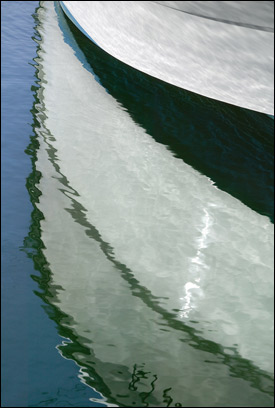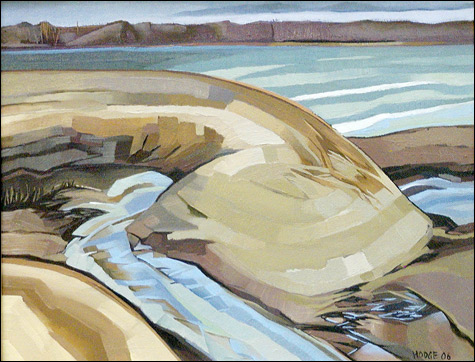
SUBLIME SUBTLETY: John Foraste’s Boat and Water
|
As New Englanders know, sights and impressions are endless wherever land and water meet. Numerous artists are making that point in a fund-raising art exhibition and sale at the Save the Bay Center in Providence, adjacent to the Johnson & Wales Harbor Campus.
Nearly 100 paintings and photographs are on display in the environmental organization’s new home. For the past 18 months, they have occupied a bermed and sod-topped structure that could pass for a sculpture itself.
The bad rap that seascapes have gotten is sometimes deserved, considering those miles of relentlessly uninspired canvas we’ve all trudged past. There is a sprinkling of the conventional in this show, a lighthouse here and there, but even those are rescued by good technique.
Confining the show to images that include water is a restriction, but in practice the subject matter here could hardly be more diverse. There are not only the dramatic waves crashing on the rocks and ocean-horizon sunsets that you would expect, but also images that come as much from imagination as from observation.
The local professionals seem to be taking the opportunity to showcase their best work. The artists I’m familiar with are representing themselves with standout contributions. Newport photographer Onne van der Wal, for example, not only has a print of his dramatic, sunset-neon Red Sail but also includes a subtle composition of sail fragments, Mariette Boom.
Some of the works hold up worlds in figurative grains of sand, such as Kris Donovan’s watercolor study of water-rounded beach stones. A found object — amidst debris, a ball sporting a cartoon face — is the content of George Walsh’s East Providence Terminal Series — Cinch! In Rock in Intertidal Zone, John Foraste focuses on a single water-glistening, barnacle-encrusted subject.
Speaking of subtlety, Boat and Water, by retired longtime Brown University staff photographer Foraste, is an exquisitely restful image that simply presents the curve of a portion of a hull on shimmering water. The photographers here have found peaceful images almost exclusively. Kate Petrie’s Geese in Sea Smoke is as gentle as that peaceful description. Michael Miller has eight quiet sights on display, from a stark white rowboat mirrored on calm water to an estuary meandering through marsh grass.
On the other hand, some painters have tapped the fury of the ocean. Through thick brushstrokes and palette knife smears, David Barnes’s White Rock conveys the blurred impression we get of crashing waves. The Tumultuous Sea, by Richard Grosvenor, is a watercolor that gives cumulus clouds the energy of such sights by merging sky and pounded rocky shore.

EVOCATIVE AMBIENCE: Kathy Hodge’s Change.
|
Yes, getting us to notice the overlooked or see the familiar in a new way is a time-honored duty of artists. Grosvenor emphasizes the landscape quality of the Newport Bridge by painting it as a diptych. John MacGowan does more in Pell Bridge, painting in only hints of the supporting cables so that the towering support structures look as formidable as skyscrapers. While we’re on the subject, Richard Benjamin’s Newport Bridge Winter Sunrise uses the undeniable (if no longer unimpeachable) realism of photography to give us a vicarious visual thrill. The structure rests on a sensuously warm yellow patch beneath clouds whose undersides glow.
Capturing evanescent light conditions has been a prideful accomplishment for artists of all mediums, long before Impressionists and camera-wielders made it a raison d’être. Bristol artist Tom Deininger is largely known for his ingenious found-object assemblages, but here six oils from his “Horizon Series” play theme and variation with a sea and sky above a sliver of beach. Denise DiGangi does the same with several studies of skies, one gloriously orange and another equally impressive from gray clouds that slash diagonally through an overcast sky.
But perhaps my favorite works here are by artists who exchange detail for evocative ambience in representational paintings. Dora Atwater Milliken’s series — Great Day, Late Day, blue and clear ones, etc. — are very good at presenting just enough, suggesting a rolling sea with brisk slashes of grays and blues, or marsh grass as just a scribble of darker green over lighter. Change, by Kathy Hodge, is a study of tidepool rocks that reduces the scene to tonal shadings but is visually complex enough to satisfy repeated viewings.
Several dozen works in the show are online at www.savethebay.org. A closing reception will be held January 26 from 5 to 7 pm.
“Paintings & photographs of narragansett bay” | Save the Bay, 100 Save the Bay Dr, Providence | Through Jan 26